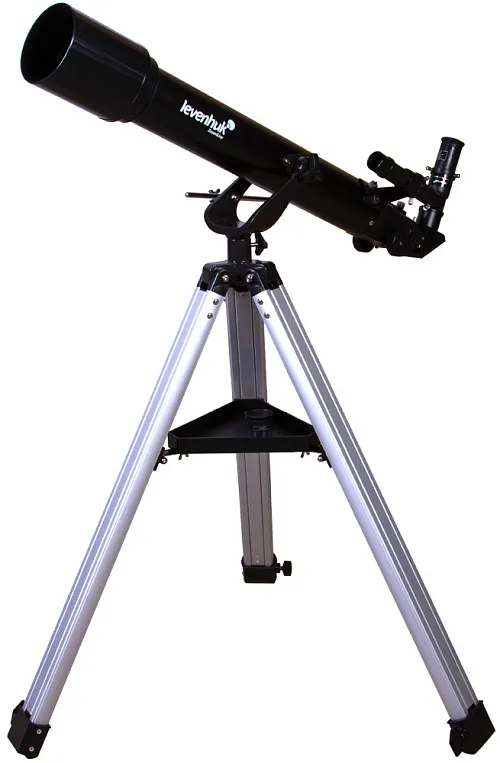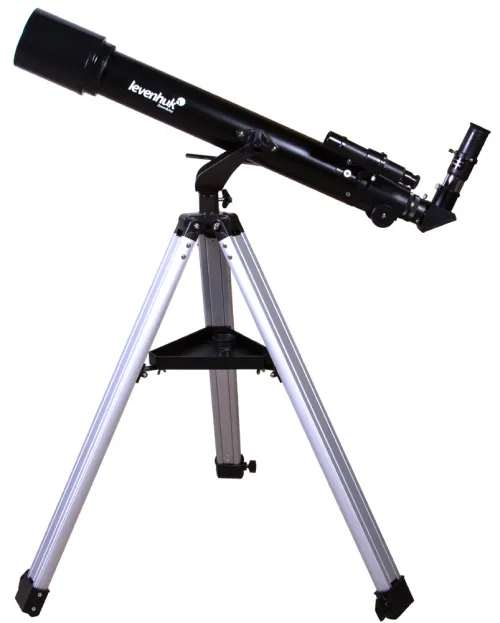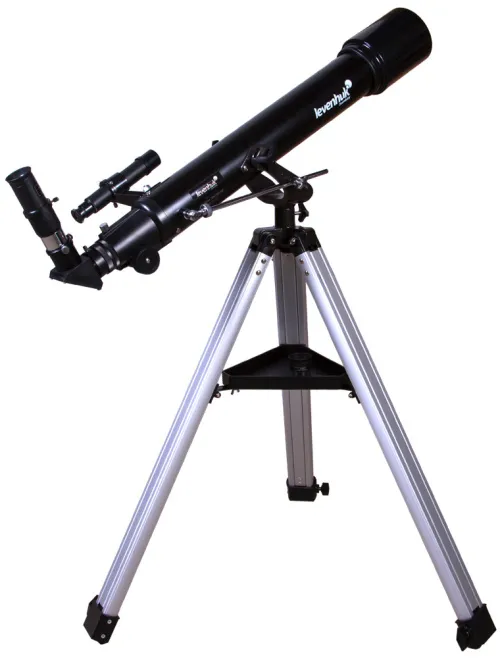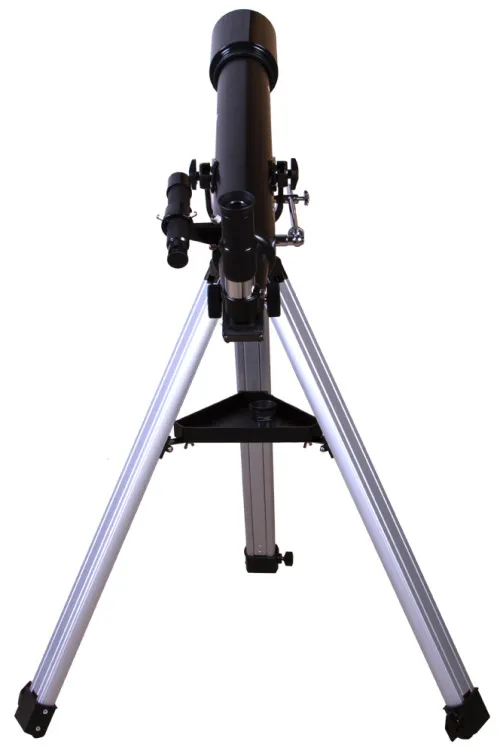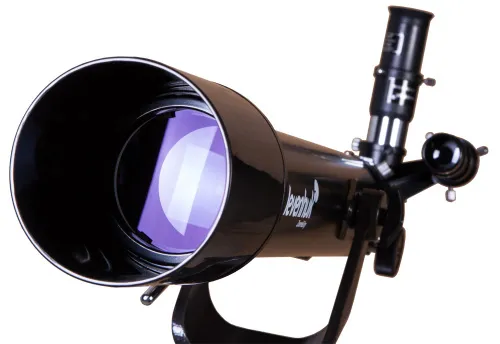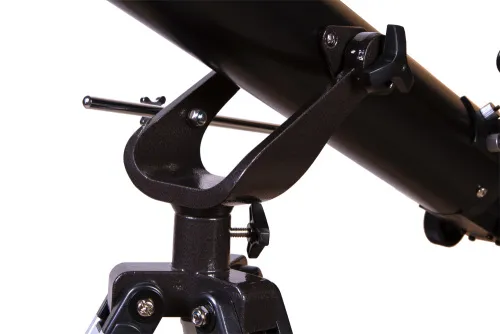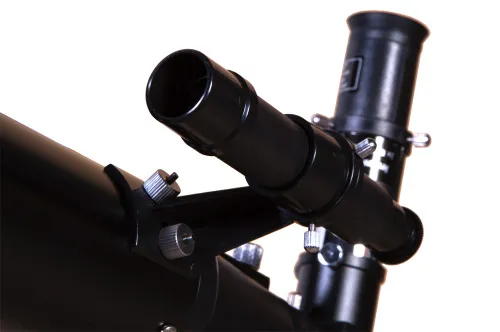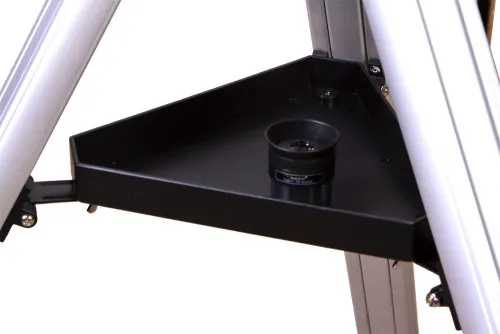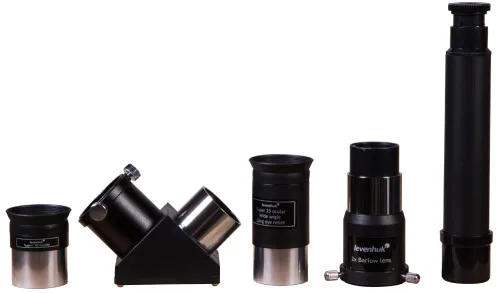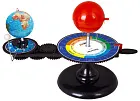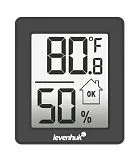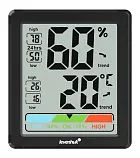Levenhuk Skyline 70x700 AZ Telescope
Refractor. Objective lens diameter: 70mm. Focal length: 700mm
| Product ID | 24295 |
| Brand | Levenhuk, Inc., USA |
| Warranty | lifetime |
| EAN | 0611901508924 |
| Package size (LxWxH) | 11.8x38.6x9.8 in |
| Shipping Weight | 14.3 lb |
Levenhuk Skyline 70x700 AZ Telescope is a classic refractor with an azimuth mount. It allows you to examine in detail planets and their satellites, as well as the surface structure of celestial objects. Due to the long focus (700 millimeters, 27.6 inches), the image provided is very clear. In combination with high resolution (1.9 arcseconds), this allows us to study the surface of planets, lunar craters and fractures, and various atmospheric phenomena. This telescope is perfect for terrestrial observations and the study of double stars. As far as long distance objects are concerned, you can see all the Messier objects very well.
Features:
- The telescope has a factory default adjustment and does not require additional and frequent adjustment;
- Contrast and sharp images in high resolution without chromatic aberration;
- Highly detailed pictures even at large aperture;
- Can be used for photographing the Moon and planets;
- Suitable for both terrestrial and astronomical observations;
- Ideal for planetary observations and observations of binary stars;
- Suitable for beginners.
The kit includes:
- Telescope optical tube (optical elements inside)
- SUPER 25 and SUPER 10 eyepieces
- Altazimuth mount AZ2
- Aluminum tripod
- 2x Barlow lens
- Diagonal mirror
- User manual and lifetime warranty
The telescope is mounted on a powerful and stable mount AZ2, which is well suited for medium-sized telescopes. Such construction is especially popular among novice astronomers, since you can manage the telescope easily and conveniently. The mount has a special shelf for accessories, and it is light and easy to use. The aluminum tripod has a height adjustment.
Two achromatic eyepieces SUPER 10 and SUPER 25 with a 1.25-inch (31.75-millimeter) diameter are included in the package and serve as powerful image correction tools. The optics used in the eyepiece are glass with a special coating. Field of view is 50–52 degrees.
| Product ID | 24295 |
| Brand | Levenhuk, Inc., USA |
| Warranty | lifetime |
| EAN | 0611901508924 |
| Package size (LxWxH) | 11.8x38.6x9.8 in |
| Shipping Weight | 14.3 lb |
| Optical design | refractor |
| Optical scheme | achromat |
| Objective lens diameter (aperture), in | 2.8 |
| Highest practical power, x | 140 |
| Aperture ratio | f/10 |
| Resolution threshold, arcseconds | 1.9 |
| Limiting stellar magnitude | 11.2 |
| Eyepieces | SUPER 10mm (70x), SUPER 25 mm (28x) |
| Eyepiece barrel diameter, in | 1.25 |
| Barlow lens | 2x |
| Finderscope | optical, 6x24 |
| Focuser | 1.25", rack & pinion |
| Tripod | aluminum |
| Tripod height (adjustable), in | 25.59–49.21 |
| Mount | alt-azimuth |
| User level | for children, beginners |
| Observed object | planets of the Solar System |
Convenient diagrams that describe how to install additional accessories on refractors and catadioptric telescopes
Find out how to assemble a telescope on an example of the Levenhuk Skyline 90x900 EQ telescope
This short guide will help you avoid typical mistakes and learn more about telescope and mounting types
The basics of astronomical observations for beginners
In this article we have gathered answers to some of the most frequently asked questions about telescopes
The most interesting celestial objects you can observe with Levenhuk telescopes
How telescopes work?
You can actually perform observations from your balcony!
All about telescope sizes, types, magnification, and mounts
Learn how to set up and use the telescope properly
Astronomy in light-polluted skies. Find out what you can observe in the city
Read an interesting comprehensive article on telescopes for little astronomers
The pictures are made with Levenhuk telescopes
Celestial objects you can observe with telescopes of different apertures
Colored and vivid images of galaxies, planets and star clusters entrance everyone who is fascinated by boundless space
Find an interesting review on the history of the changes to a refracting telescope
To make the process of choosing a telescope easier, we will tell you about the characteristics of the most popular types of telescopes today
Learn everything you need to know about refractor telescopes to make the right choice
binary stars with angular separation of over 2"", e.g. Albireo, Mizar, etc.;
faint stars (up to 11.5 stellar magnitude);
sunspots (with an aperture filter);
phases of Venus;
lunar craters (8 km in diameter);
polar ice caps and maria on Mars during oppositions;
atmospheric bands on Jupiter and the Great Red Spot (GRS) under ideal conditions, four moons of Jupiter;
rings of Saturn, Cassini Division under ideal conditions, pink atmospheric band on the planetary disk;
Uranus and Neptune as stars;
large globular, e.g. M13, and open clusters;
almost all of the Messier objects (not detailed)
Is there any significant difference in image quality between these telescope models?
Levenhuk Skyline 70x700 AZ
Levenhuk Skyline 76x700 AZ
Levenhuk Skyline 70x900 EQ
The best one is, of course, the most expensive one, right?
Thanks!
And, if I get it right, I will need special lenses in order to observe the Sun, planets (for example Saturn and Jupiter) is it so? are they included in the kit?
2. Produced image depends on an eyepiece used and observing conditions.
3. The Earth is rotating, celestial objects are moving - under higher increase it is just more noticeable.
Also we need to add that telescope's magnification (the highest practical power) is its diameter multiplied by 2! So when choosing a telescope you need to focus on what you want to see through it, choose lens telescope in case of observing planets (for example, Levenhuk Skyline 70x700 AZ Telescope) or mirror one for deep-sky observations.
Binary stars with the separation between their components more than 2" - Albireo, Mizar, etc.
Faint stars up to 11.5 stellar magnitude
Sunspots (with aperture filter only)
The phases of Venus
Lunar craters with a diameter of 5 miles
Polar caps and seas on Mars during opposition
Atmospheric flows of Jupiter and even the Great Red Spot in perfect conditions, 4 of Jupiter moons
The rings on Saturn and the Cassini Gap in excellent visibility conditions
Uranus and Neptune as stars
Large globular clusters (such as Messier 13) and open clusters
Almost every object from the Messier catalogue (but without details).
Best regards and thanks a lot =)
What do the the names of SUPER10 and SUPER25 eyepieces mean

